
A torsion bar suspension, also known as a torsion spring suspension, is any vehicle suspension that uses a torsion bar as its main weight-bearing spring. One end of a long metal bar is attached firmly to the vehicle chassis; the opposite end terminates in a lever, the torsion key, mounted perpendicular to the bar, that is attached to a suspension arm, a spindle, or the axle. Vertical motion of the wheel causes the bar to twist around its axis and is resisted by the bar's torsion resistance. The effective spring rate of the bar is determined by its length, cross section, shape, material, and manufacturing process.
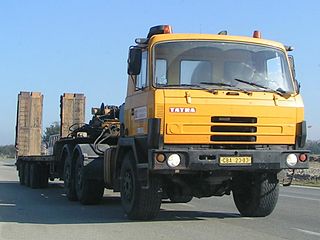
The Tatra 815 is a truck family, produced by Czech company Tatra. It uses the traditional Tatra concept of rigid backbone tube and swinging half-axles giving independent suspension. The vehicles are available in 4x4, 6x6, 8x8, 10x8, 10x10, 12x8 and 12x12 variants. There are both air-cooled and liquid-cooled engines available with power ranging from 230–440 kilowatts (310–590 hp). As a successor to Tatra 813 it was originally designed for extreme off-road conditions, while nowadays there are also variants designated for mixed use. The gross weight is up to 35,500 kg (78,264 lb).
A swing axle is a simple type of independent suspension, almost always for the rear axles, designed and patented by Edmund Rumpler in 1903. This was a revolutionary invention in automotive suspension, allowing driven (powered) wheels to follow uneven road surfaces independently, thus enabling the vehicle's wheels to maintain better road contact and holding; plus each wheel's reduced unsprung weight means their movements have less impact on the vehicle as a whole. The first automotive application was the Rumpler Tropfenwagen, later followed by the Mercedes 130H/150H/170H, the Standard Superior, the Volkswagen Beetle and its derivatives, the Chevrolet Corvair, and the roll-over prone M151 jeep amongst others.

The Tatra 77 (T77) is one of the first serial-produced, truly aerodynamically-designed automobiles, produced by Czechoslovakian company Tatra from 1934 to 1938. It was developed by Hans Ledwinka and Paul Jaray, the Zeppelin aerodynamic engineer. Launched in 1934, the Tatra 77 is a coach-built automobile, constructed on a platform chassis with a pressed box-section steel backbone rather than Tatra's trademark tubular chassis, and is powered by a 60 horsepower (45 kW) rear-mounted 2.97-litre air-cooled V8 engine, in later series increased to a 75 horsepower (56 kW) 3.4-litre engine. It possessed advanced engineering features, such as overhead valves, hemispherical combustion chambers, a dry sump, fully independent suspension, rear swing axles and extensive use of lightweight magnesium alloy for the engine, transmission, suspension and body. The average drag coefficient of a 1:5 model of Tatra 77 was recorded as 0.2455. The later model T77a, introduced in 1935, has a top speed of over 150 km/h (93 mph) due to its advanced aerodynamic design which delivers an exceptionally low drag coefficient of 0.212, although some sources claim that this is the coefficient of a 1:5 scale model, not of the car itself. Recent article confirmed the Tatra 77/77a drag coefficient for real full-size car as 0.36.
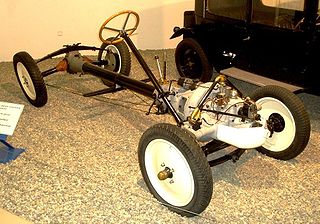
Backbone tube chassis is a type of automobile construction chassis that is similar to the body-on-frame design. Instead of a two-dimensional ladder-type structure, it consists of a strong tubular backbone that connects the front and rear suspension attachment areas. A body is then placed on this structure. It was first used in the English Rover 8hp of 1904 and then the French Simplicia automobile in 1909.

The TatraT813 was a truck produced in Czechoslovakia by the Tatra company. It was produced from 1967 to 1982. The basic representative of this series was a military version of the 8×8 Kolos (Colossus), which was able to pull trailers up to a total weight of 100 tons. Tatra also produced a civilian version in either 6×6 or 4×4. After fifteen years of production, 11,751 vehicles were built in all modifications. Many units were exported to the USSR, East Germany, Romania and India.

The Tatra 148 was a truck produced in Czechoslovakia by the Tatra company.
The SA was Toyota's first new passenger car design after World War II. It was the first in a family of vehicles before the introduction of the Crown. A series of light trucks also shared the chassis and major components of these passenger cars.
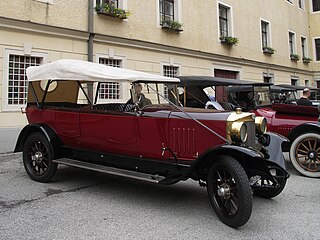
Steyr was an Austrian automotive brand, established in 1915 as a branch of the Österreichische Waffenfabriks-Gesellschaft (ÖWG) weapon manufacturing company. Renamed Steyr-Werke AG in 1926 and merged with Austro-Daimler and Puch into Steyr-Daimler-Puch AG, it continued manufacturing Steyr automobiles until 1959.

The Tatra T11 is an automobile that was produced from 1923 through 1927. It was the first Tatra model to use backbone tube chassis, swinging half-axles and air-cooled engine, the development of which is still in use on the trucks produced by Tatra to this day.

From 1931 to 1939, Daimler-Benz AG produced three cars with rear engine as well as a few prototypes. Production numbers remained low for each of these models, especially compared with the production of conventional front-engine Mercedes-Benz cars.

The Tatra 30 is an automobile formerly made by the Czech manufacturer Tatra. It was manufactured between 1926 and 1928. From 1928 to 1931 the car was fitted with a newer engine and is therefore called the Tatra 30/52.

The Tatra 12 is an automobile produced by Czech manufacturer Tatra between 1926 and 1933. It was replaced by the Tatra 57 in 1932.

The Tatra 70 is a Czechoslovak luxury car that was made by Tatra at Kopřivnice from 1931 to 1937. It succeeded the Tatra 31.
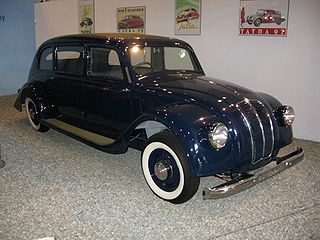
The Tatra 90 is a Czechoslovak prototype mid-size car, made by Tatra in Kopřivnice in 1935.

The Steyr 120 Super, Steyr 125 Super and Steyr 220 were a series of medium-sized cars built by the Austrian firm Steyr-Daimler-Puch from 1935 to 1941. The moderately streamlined body was designed by technical director Karl Jenschke (1899-1969) and was manufactured by Gläser-Karosserie GmbH in Dresden. The design had a close resemblance to the smaller Steyr 100.

Nesselsdorf (NW) type T was a luxury car. As the company changed its name the model was renamed to Tatra 20 in 1919. It was successor to the highly successful model NW type S. It was made at the same time as NW type U until 1925, when both of the models were replaced by Tatra 17. It is currently a vintage model, with only three examples known to exist. BMW owns one, while another is owned by a U.S. car collector.

The original Škoda Superb is a full size luxury car that was made by the Czechoslovak car manufacturer ASAP, later AZNP from 1934 to 1949. It was the company's first car with a V8 engine and all-wheel drive.
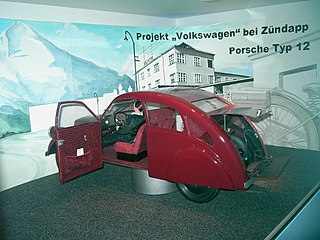
The Porsche Type 12 was a German project to develop an "Everyman's automobile" for Zündapp. Fritz Neumeyer, then owner of Zündapp, ordered Ferdinand Porsche to design and build the prototype in 1931. Eventually, two saloons, and one drophead coupé were built. All of those cars were lost during World War II, the last one in a bombing raid in Stuttgart in 1945. The Type 12 is considered an important early step in the development of the original Volkswagen. A replica of the Type 12 is on static display at the Museum Industrielkultur in Nürnberg.
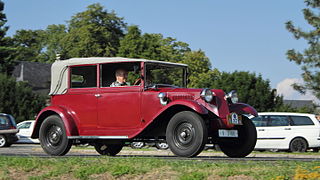
The Tatra 52 is a Czechoslovak mid-size car that was made by Závody Tatra from 1931 to 1939. It was built both at the Tatra factory in Kopřivnice and also under licence by Rohr at Frankfurt am Main in Germany.





















